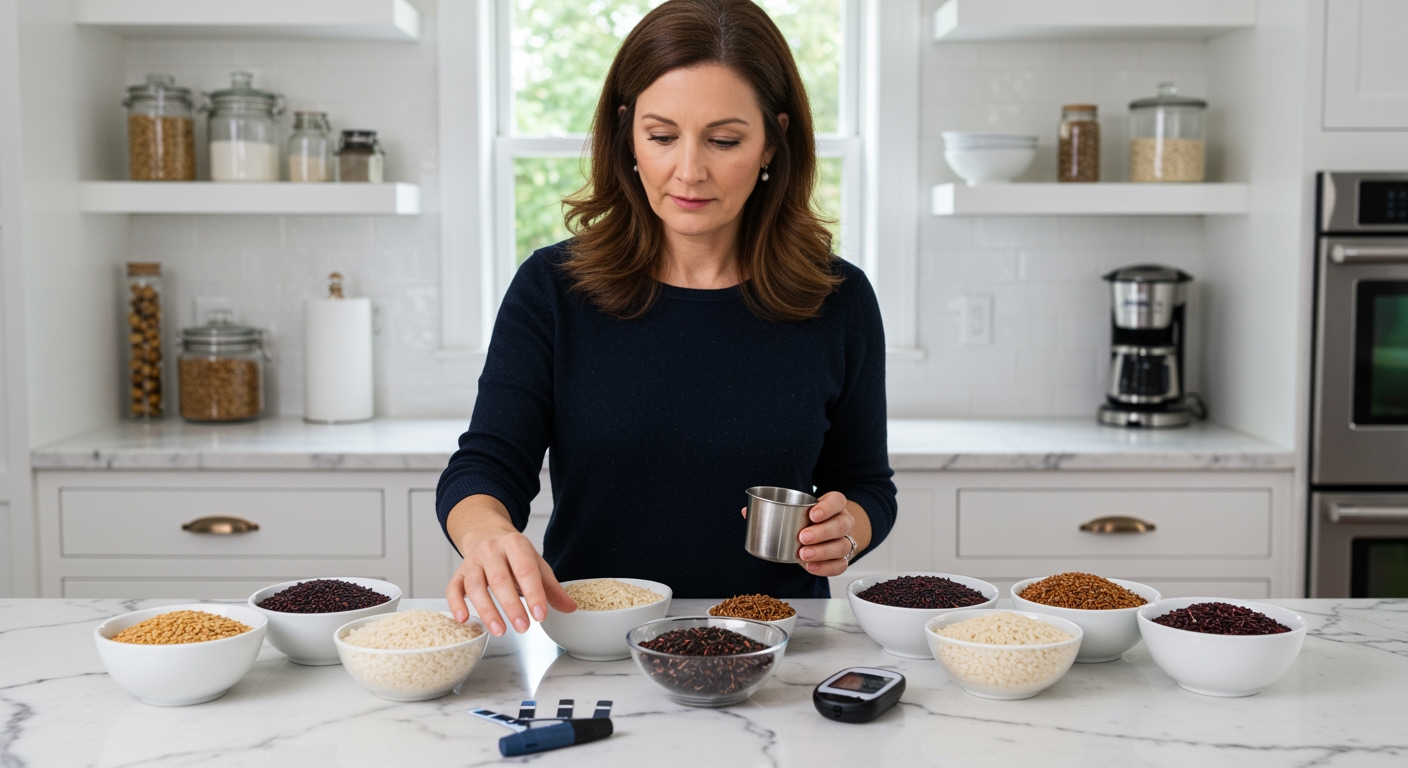✪ Key Takeaway: Rice can be part of a diabetes diet when you choose the right type, control portions, and time your meals properly.
Introduction
Your doctor just told you that you have diabetes, and suddenly everyone is warning you about rice.
You might be wondering if you need to give up this staple food forever or if there is a way to still enjoy it safely.
Hi, I am Abdur, your nutrition coach, and today I am going to explain exactly how rice affects your blood sugar and which types you can still eat with diabetes.
Does White Rice Really Spike Blood Sugar?
White rice does cause a rapid spike in blood glucose levels within 30 minutes of eating.
This happens because white rice has been stripped of its fiber and nutrients during processing.
Your digestive system breaks down white rice into glucose very quickly, sending it straight into your bloodstream.
Research from Harvard School of Public Health shows that people who eat white rice regularly have a 27% higher risk of developing type 2 diabetes.
The glycemic index of white rice ranges from 70 to 89, which puts it in the high category.
This means your pancreas has to work overtime to produce enough insulin to handle the glucose surge.
✪ Fact: One cup of cooked white rice contains about 45 grams of carbohydrates, equivalent to 11 teaspoons of sugar.
Which Rice Types Are Better For Diabetes?
Brown rice is your best choice because it retains its fiber-rich bran layer.
The fiber in brown rice slows down digestion and prevents rapid blood sugar spikes.
Studies show that replacing white rice with brown rice can reduce diabetes risk by 16%.
Wild rice is another excellent option with even more fiber and protein than brown rice.
Black rice and red rice contain powerful antioxidants called anthocyanins that may help improve insulin sensitivity.
Basmati rice, especially the brown variety, has a lower glycemic index compared to other white rice types.
The aging process of basmati rice creates resistant starch, which your body digests more slowly.
✪ Pro Tip: Cook rice the day before and refrigerate it to increase resistant starch content by up to 60%.
How Much Rice Can You Eat With Diabetes?
Portion control is absolutely critical when eating rice with diabetes.
A safe serving size is one-third cup of cooked rice, which contains about 15 grams of carbohydrates.
This amount fits within the recommended 45-60 grams of carbohydrates per meal for most people with diabetes.
You should always measure your rice instead of eyeballing portions because most people underestimate serving sizes.
Eating rice with protein and healthy fats helps slow down glucose absorption.
Try pairing your rice with grilled chicken, fish, or a handful of nuts to create a more balanced meal.
Adding vegetables to your rice increases fiber content and helps you feel full with smaller portions.
✪ Note: Use a measuring cup or food scale until you can accurately estimate proper portions by sight.
When Should You Eat Rice With Diabetes?
Timing matters just as much as the type and amount of rice you eat.
Your body handles carbohydrates better earlier in the day when insulin sensitivity is naturally higher.
Eating rice at lunch instead of dinner gives your body more time to process the glucose before bedtime.
Never eat rice on an empty stomach because this causes the fastest blood sugar spike.
Start your meal with a salad or vegetables to slow down rice digestion.
If you exercise regularly, eating rice within 2 hours after your workout can help replenish muscle glycogen without spiking blood sugar as much.
Monitor your blood glucose levels 2 hours after eating rice to understand how your body responds.
✪ Pro Tip: Keep a food diary to track which rice types and portions work best for your blood sugar control.
Can Rice Alternatives Work Better?
Several rice alternatives can provide similar satisfaction with better blood sugar control.
Cauliflower rice contains only 5 grams of carbohydrates per cup compared to 45 grams in regular rice.
Shirataki rice, made from konjac root, has virtually zero carbohydrates and calories.
Quinoa offers complete protein and more fiber than brown rice, though it still contains carbohydrates.
Barley and bulgur wheat have lower glycemic indexes than rice and provide more nutrients.
You can also mix regular rice with these alternatives to reduce overall carbohydrate content while maintaining familiar taste and texture.
The key is finding substitutes that you actually enjoy eating long-term rather than forcing yourself to eat foods you dislike.
✪ Fact: Mixing half regular rice with half cauliflower rice can cut carbohydrates by 50% while maintaining familiar texture.
The Bottom Line
Rice is not completely off-limits for people with diabetes, but you need to be smart about your choices.
The right rice in the right amount at the right time can fit into a healthy diabetes management plan.
I would love to hear about your experience with rice and diabetes management, so please share your questions or feedback in the comments below.
References
At NutritionCrown, we use quality and credible sources to ensure our content is accurate and trustworthy. Below are the sources referenced in creating this article:
- Harvard School of Public Health: Eating White Rice Regularly May Raise Type 2 Diabetes Risk
- PubMed Central: Rice Consumption and Diabetes Risk
- JAMA Internal Medicine: White Rice Consumption and Risk of Type 2 Diabetes
- Diabetes Care Journal: Global Perspective on White Rice Consumption and Diabetes





